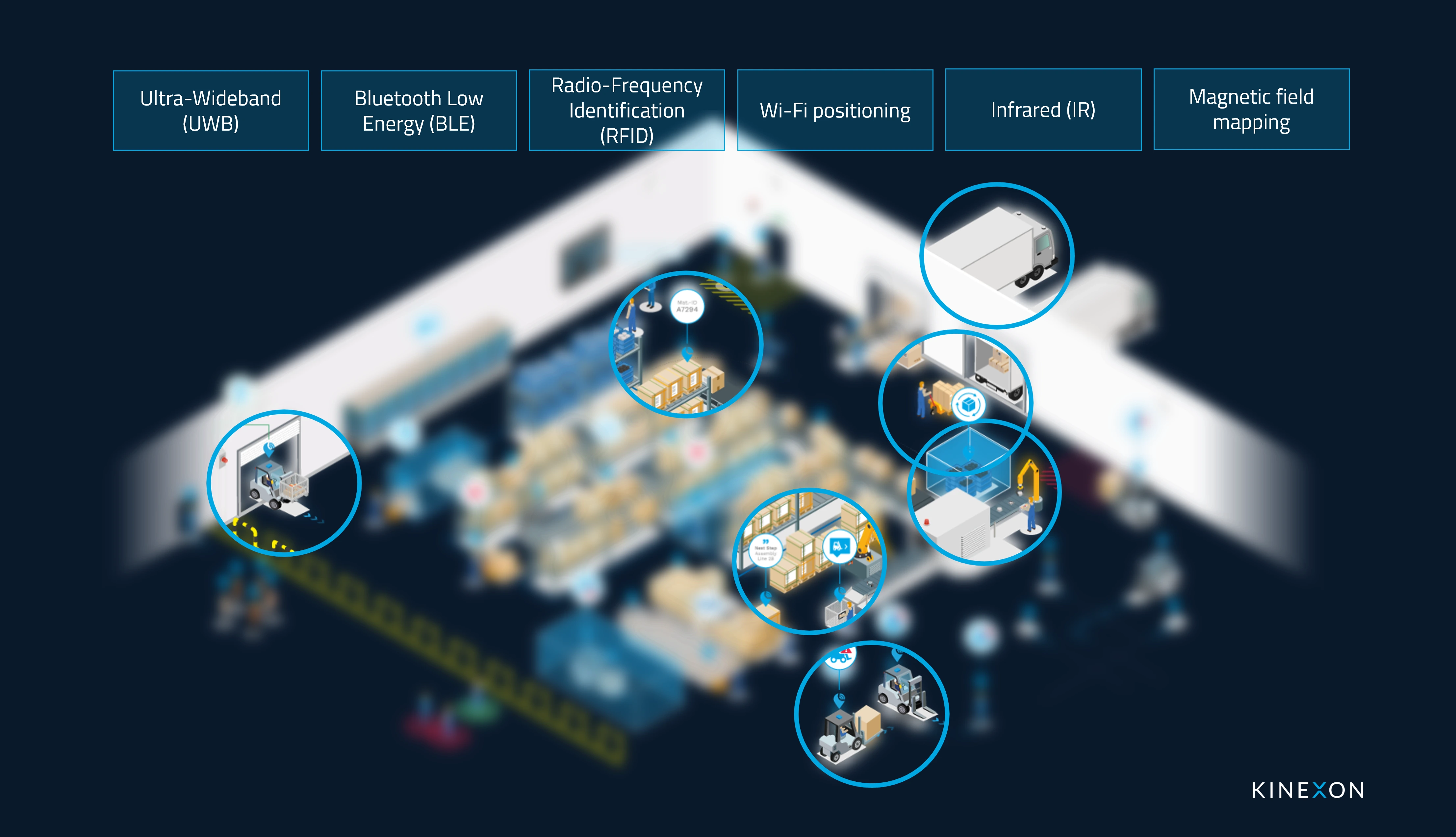Indoor Positioning Systems (IPS): Understanding Their Role on Shopfloors and in Warehouses
Learn how Indoor Positioning Systems (IPS) can transform operations in intralogistics and production. And understand how they relate to RTLS (Real Time Location Systems)

Imagine navigating a busy manufacturing facility, trying to locate a specific load carrier, tools, semi-finished goods or specialty equipment in the middle of a vast, bustling space. Outdoors, you would instinctively rely on GPS for directions, but inside, the lack of a reliable signal leaves you unsure which way to go. This is where Indoor Positioning Systems (IPS) come into play. IPS transforms the way we interact with indoor spaces, helping us efficiently find equipment, personnel, or materials, and ultimately improving both safety and productivity.
In industrial, commercial, and even healthcare environments, knowing exactly where key assets or personnel are at any given moment is critical. Whether it's locating a piece of equipment in a large warehouse, tracking a hospital patient's location, or navigating through a complex office building, IPS enables accurate, real-time indoor navigation and tracking.
What is an Indoor Positioning System (IPS)?

An IPS refers to any system that allows for the detection, location, and tracking of objects or people inside buildings. These systems can be built using a variety of technologies, such as:
- Bluetooth Low Energy (BLE) beacons
- Radio-Frequency Identification (RFID)
- Wi-Fi positioning
- Ultra-Wideband (UWB)
- Infrared (IR)
- Magnetic field mapping
Each of these technologies offers different levels of accuracy and functionality depending on the application and environment. For example, BLE and UWB are commonly used in real-time tracking because they offer high precision. RFID is often used for tracking assets over larger areas but may not update the location in real time.
Clarifying the Terminology: IPS vs. RTLS
When exploring location tracking technologies, you may come across terms like Indoor Positioning System (IPS) and Real-Time Locating System (RTLS). These terms are often used interchangeably, leading to confusion, but they really have a hierarchical relationship. To put it simply, IPS is the umbrella term that refers to a variety of technologies that help track and position objects or people inside buildings.
As a subset of IPS, RTLS specifically focuses on real-time tracking of assets, people, or equipment. These systems use technologies like ultra-wideband technology (UWB), BLE, and active RFID to continuously monitor the movement and location of the tracked objects. In a warehouse, for instance, RTLS can track the exact movement of forklifts, pallets, or workers, providing a dynamic view of operations in real time. In other words, RTLS is a certain category of Indoor Positioning Systems.
Real-Time Locating Systems (RTLS) and RFID
However, some IPS solutions don't necessarily need real-time precision. For example, RFID-based systems might only need to confirm whether an item is in a certain area (such as a storage room or dock), rather than updating its exact position every second. In these cases, the goal is to know that an object is present within a defined zone, rather than pinpointing its location moment by mom. If you are interested in a more comprehensive comparison between UWB based RTLS and RFID-Systems, we have a dedicated blog article for that, too.
The Value of IPS in Modern Operations
Indoor Positioning Systems provide immense value to businesses and organizations by offering:
- Enhanced visibility and process control: Know exactly where critical assets or personnel are located at any given time and analyze operational processes for improvement potentials.
- Operational efficiency: Optimize workflows by reducing the idle times, and disruptions, thus production stops.
- Automation at scale: Digitize the movements and locations of assets on the shopfloor and in warehouses, to enable automation based on positional data.
- Increased safety: Ensure the safe movement of personnel or high-value assets, especially in hazardous environments like factories or construction sites, by tracking their real-time location.
- Seamless integration: Leverage modern IPS solutions by integrating them into existing systems like WMS, MES, ERP, and autonomous fleet management systems to gain a comprehensive, data-driven view of your operations.
Conclusion
To summarize, an Indoor Positioning System (IPS) is an overarching term that includes a wide variety of technologies for tracking and positioning within indoor spaces. Real-Time Locating Systems (RTLS) are a key subset of IPS, focusing on continuously monitoring the exact location of objects or people. There are a variety of other technologies that underly IPS solutions. Companies need to carefully define their use cases to be able to identify the type of IPS system that best serves their need.
As industries continue to innovate, IPS will remain a critical enabler of visibility, efficiency, and safety across sectors like logistics, manufacturing, healthcare, and beyond.
Discover more about KINEXON OS – the platform that helps you process, visualize, and leverage all position data regardless of the technology you use to obtain it.
Interested in learning more?
Do you wish to define your use cases to be able to identify the type of IPS system that best serves your need?
.jpeg)
More Resources
Stay Up to Date
Subscribe to our newsletter and stay connected. You can unsubscribe at any time.
Ready to automate your industrial operations?
Schedule a meeting with our experts to connect and automate your operations.
Get in touch